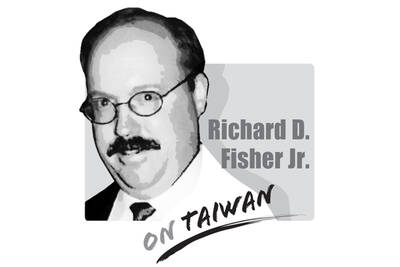The Chinese Nationalist Party (KMT) and Chinese Communist Party (CCP) held their fourth economic forum over the weekend in Shanghai. Since Council for Economic Planning and Development Vice Chairman San Gee (單驥) is a political appointee, his participation in the forum was controversial. Premier Liu Chao-shiuan’s (劉兆玄) announcement that civil servants were allowed to visit China was an attempt to justify the KMT-CCP meetings after the fact.
The Regulations Governing Entry Permission to Mainland China for Government Employees and Persons with Special Status in the Taiwan Area (台灣地區公務員及特定身分人員進入大陸地區許可辦法) stipulate that political appointees can only visit China to take part in conferences organized by international bodies. The KMT-CCP forum hardly qualifies.
This is not the first time that a political appointee has broken the law to visit China. Financial Supervisory Commission Vice Chairwoman Lee Jih-chu’s (李紀珠) attendance at a cross-strait financial seminar last month was another example.
President Ma Ying-jeou’s (馬英九) administration is committed to promoting cross-strait exchanges, but it must draw up supplementary measures to make sure they are legal. The Mainland Affairs Council should have amended the law earlier. Since it did not, the KMT has only itself to blame for the criticism it has received.
The main obstacle for civil servants visiting China lies in the terms of the Regulations Governing Entry Permission to Mainland China for Government Employees and Persons with Special Status in the Taiwan Area. But since this regulation is an executive order, it can be amended by the Executive Yuan simply by public announcement. Even if it were necessary to amend the Act Governing Relations between the Peoples of the Taiwan Area and the Mainland Area (臺灣地區與大陸地區人民關係條例), which can only be done by the legislature, this would not be hard since the KMT holds a legislative majority.
Considering that cross-strait exchanges are a mainstay of current policy, one would expect the government to remove legal obstacles in an orderly way ahead of time. The current confusion highlights the fact that the administration is in a rush to put all its eggs in the China basket. But China may not be the safe haven from the global economic storm that the KMT government imagines.
Jia Qinglin (賈慶林), chairman of China’s People’s Political Consultative Conference says that China wants to sign a comprehensive economic cooperation agreement with Taiwan. The pact would be modeled on the Closer Economic Partnership Arrangement (CEPA) Beijing signed with Hong Kong in 2003. Beijing wants to create a single Chinese market, using economic union to pave the way for political union.
The CEPA only brought transitory benefits to Hong Kong. Its costs have outweighed its benefits. Now that the financial tsunami has hit, the economic bubble has burst and Hong Kong’s ailing economy is more dependent on China than ever.
Taiwan’s leaders should open their eyes to the fact that China, too, is suffering from the global economic downturn, and many Taiwanese businesses with investments in China are pulling out. This is hardly the time to be rushing headlong into China.
Rather than putting their faith in a shaky Chinese market, the government should try to boost domestic demand and salvage the economy by investing in Taiwan.

On Sept. 3 in Tiananmen Square, the Chinese Communist Party (CCP) and the People’s Liberation Army (PLA) rolled out a parade of new weapons in PLA service that threaten Taiwan — some of that Taiwan is addressing with added and new military investments and some of which it cannot, having to rely on the initiative of allies like the United States. The CCP’s goal of replacing US leadership on the global stage was advanced by the military parade, but also by China hosting in Tianjin an August 31-Sept. 1 summit of the Shanghai Cooperation Organization (SCO), which since 2001 has specialized
In an article published by the Harvard Kennedy School, renowned historian of modern China Rana Mitter used a structured question-and-answer format to deepen the understanding of the relationship between Taiwan and China. Mitter highlights the differences between the repressive and authoritarian People’s Republic of China and the vibrant democracy that exists in Taiwan, saying that Taiwan and China “have had an interconnected relationship that has been both close and contentious at times.” However, his description of the history — before and after 1945 — contains significant flaws. First, he writes that “Taiwan was always broadly regarded by the imperial dynasties of
The Chinese Communist Party (CCP) will stop at nothing to weaken Taiwan’s sovereignty, going as far as to create complete falsehoods. That the People’s Republic of China (PRC) has never ruled Taiwan is an objective fact. To refute this, Beijing has tried to assert “jurisdiction” over Taiwan, pointing to its military exercises around the nation as “proof.” That is an outright lie: If the PRC had jurisdiction over Taiwan, it could simply have issued decrees. Instead, it needs to perform a show of force around the nation to demonstrate its fantasy. Its actions prove the exact opposite of its assertions. A
A large part of the discourse about Taiwan as a sovereign, independent nation has centered on conventions of international law and international agreements between outside powers — such as between the US, UK, Russia, the Republic of China (ROC) and Japan at the end of World War II, and between the US and the People’s Republic of China (PRC) since recognition of the PRC as the sole representative of China at the UN. Internationally, the narrative on the PRC and Taiwan has changed considerably since the days of the first term of former president Chen Shui-bian (陳水扁) of the Democratic